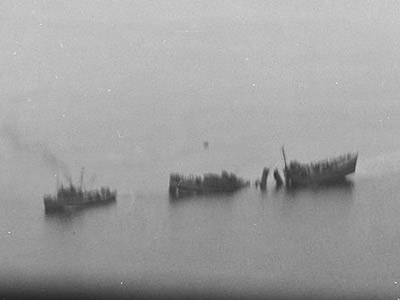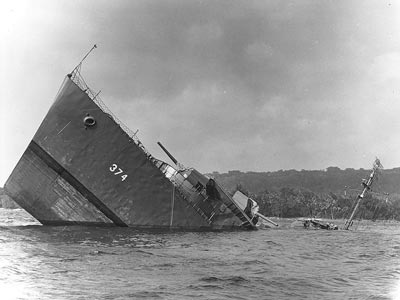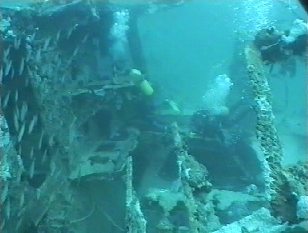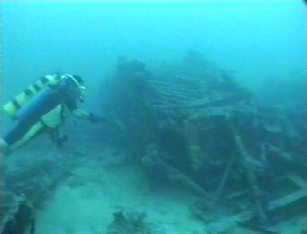|
In Santo in Vanuatu there are two major World War II American shipwrecks. The main wreck is, of course, the giant SS President Coolidge. Most people who travel to Santo go there for the main (sole in some cases) reason of diving the Coolidge. While this is a very good reason to go to Santo, the other shipwreck is well worth diving as are a number of other sites, including another shipwreck.
Designated DD-374, the USS Tucker was a Mahan class destroyer built by the Norfolk Navy Yard at Portsmouth, Virginia, USA. The keel was started on 16 June 1934 (officially laid down on 15 August 1936) and she was launched on 26 February 1936.
The USS Tucker was named after Commodore Samuel Tucker, USN, who was a famous Captain during the American Revolution. The ship was christened by Mrs Leonard Thorner, a distant cousin. One of 18 identical Mahan class destroyers built for the US Navy, the Tucker was commissioned on 23 July 1936 with Lt Commander George T. Howard in Command. Of these, six were sunk during the war and another two were severely damaged at Pearl Harbour but subsequently rebuilt. An additional three Mahans were built for the Brazilian Navy.
 |  |
| The Tucker in Massachusetts Bay, 17 November 1937 | The Tucker Norfolk Navy Yard 2 March 1937 |
The Mahan class was an advanced ship, with an unprecedented engine/boiler combination. Based on the Farragut class destroyers the Mahans were powered by two shaft General Electric turbines and four Babcock and Wilcox boilers giving 49,000 shaft horsepower. This gave the Tucker a maximum speed of 36.5 knots. Carrying up to 522 tons of oil, the ship had a range of 6500 nautical miles at 12 knots. Displacing 2103 tons at full load, the ship was 101.8 metres long and 10.67 metres wide. It was armed with five 5 inch guns, four half inch guns and 12 torpedo tubes. One of the Tucker's distinguishing features was that its superstructure was largely constructed of stainless steel. Another interesting feature was that (at least at one time in the 1930s), the Tucker had sails. See the photograph further down in this article. The sails were used to extend the time that the ship was able to be on station at a location by using the wind to move slowly or perhaps to assist the engines when moving slowly.
The Tucker became part of the destroyer forces attached to the US Battle Fleet and was based at San Diego, California. She was part of Destroyer Squadron 3, Destroyer Division 6 and served before World War II along the US West Coast and Hawaii. In February 1939 she travelled to the Caribbean where she was part of Fleet Problem XX, an exercise observed by President Franklin D. Roosevelt.
 |
Lt Com (later Admiral)
William R. Terrell
Skipper of the USS Tucker
Photo courtesy of his family |
As the situation detoriated, with war imminent, the Tucker moved to Hawaiian waters and remained there till early 1941. On 14 February 1941 she arrived back in Pearl Harbor, Hawaii, from San Diego, and then sailed for Auckland, New Zealand. She arrived thereon 17 March 1941. This was primarily a public relations exercise.
Back in Hawaii she did some more exercises, getting back to San Diego on 19 September 1941. Soon after she returned to Hawaii as part of Task Force 19 and in early November started operations around the Hawaiian Islands. After a month she returned to Pearl Harbor for an overhaul of a tender boat.
On 7 December 1941, the USS Tucker was at berth X-8, East Loch, Pearl Harbor, undergoing the tender overhaul when the Japanese attacked Pearl Harbor. Lt Commander (later Admiral) William R. Terrell, was now the skipper of the Tucker. He had graduated from the US Naval Academy in 1921.
At 0755 Walter E. Bowe, G.M.2c, USN, spotted the incoming planes and immediately manned the after 50 calibre machine guns of USS Tucker. At 0757 the quartermaster on watch (Robert Burns, Sea.1c, USN) who was on the bridge, sounded the general alarm. Before the general alarm started ringing Bowe was firing one of the after machine guns. Lt Commander Terrell stated: "It is believed from numerous reports and comments by personnel of this and other ships that Bowe fired the first shot fired by the American Forces in Pearl Harbor".
The entire crew with the exception of about three men and four officers were on board. Under the command of the Executive Officer, Lieutenant W.H. Watson, USN, who was the senior officer on board, the ship's entire battery of guns was manned. As the Tucker was alongside the tender, USS Whitney, the five inch No 3 gun could not be fired. However all other guns and 50 calibre machine guns were manned and fired at the attacking planes during all attacks.
Ensign Lee D. Goolsby, USN, was Gunnery Officer. There were no losses to the personnel nor damage to material of the ship. Lt Commander Terrell reported that it was believed that the Tucker shot down three or four Japanese planes. HE reported that Bowe was responsible for one and possibly two of the planes shot down.
Lt Commander Terrell stated:
The performance of all personnel of this vessel was outstanding and in the best traditions of the naval service. The quick action of Bowe on his own initiative was particularly outstanding.
Chief Electrician Paul Thompson (later of Omaha, Nebraska), had enlisted in the Navy in 1938. He was on board the USS Tucker when the Japanese attacked. His post was inside the ship to make sure all the power to the turrets and other machinery kept running. He said that he was outside on-deck for a few moments and it is reported that he could see the Japanese pilots and even the expressions on their faces. When he looked over toward Battleship Row, which should have been a fairly clear view, he said there was so much smoke you really couldn't see all of what happened.
 |  |
The USS Tucker with sails in the 1930s.
The sails were used to extend time on station | Another photo of the Tucker |
The Tucker steamed out of the Harbor shortly after 1000 hours. While some repors state the the USS Tucker the honour of firing the first American shots of the War as the Japanese attacked Pearl Harbor but this is incorrect. As you can see from the report above, the commander of the USS Tucker claimed that it fired the first shots inside Pearl Harbor. The first shots of the war were made by another ship outside the harbour (USS Ward I believe) which sank a mini-submarine as it attempted to enter Pearl Harbor. The claim about firing the first shots of the War were also made to me by Hillary Bryan, the Grand-daughter of Admiral Terrell. I had originally written on this page that presumably this is what her Grandfather told her and her mother. However, as mentioned above, Terrell knew that his ship only fired the first shots within Pearl Harbor.
Immediately after the attack the Tucker patrolled off Pearl Harbor. Over the next five months the Tucker escorted convoys between San Francisco and Honolulu. From April 1942 she moved to the South Pacific and then spent four months escorting ships around Fiji, Australia and New Zealand.
Her first job was to escort USS Wright to Tutuila in American Samoa and then on to Suva in Fiji and then to Noumea in New Caledonia. The Tucker then went to Sydney arriving 27 April 1942. She took on fuel and travelled to Melbourne, Perth, Fremantle (Western Australia) and then back to Sydney. My guess is that she was escorting cargo ships in convoy on both these journeys. From Sydney, she escorted the Wright to Suva, arriving 3 June 1942. For the next month she operated from Suva and on 10 July 1942, she relieved the USS Boise on convoy escort. On 30 July 1942 she arrived in Auckland and the next day she left for Fiji.
When in Fiji, the Tucker was directed to escort a ship to Espiritu Santo, New Hebrides (now Vanuatu). The ship, SS Nira Luckenbach, departed Suva on 1 August 1942 and travelled via Efate and Malekula, both part of the New Hebrides. Note that the Luckenbach may be the same ship that the SS President Coolidge travelled in convoy from San Francisco to Melbourne in January 1942. See the Coolidge voyage page.
 |  |
| USS Gamble after she was converted | The Breese, unknown date |
Just after midnight on 3 August 1942, USS Gamble, USS Breese and USS Tracy left Luganville in Espiritu Santo, New Hebrides, to lay a series of minefields to protect Segond Channel. USS Gamble (DD123) and Breese (DD122) were Wickes class destroyers built around the end of World War I (there were 111 built). They were 314 feet long and displaced 1,090 tons and were extremely fast at 35 knots. The Gamble was decommissioned in 1922 and in 1930 it was recommissioned after being converted to a destroyer/minelayer and renumbered as DM-15. I am not sure at this time if the Breese was similarly converted. The USS Gamble was also involved later in the sinking of the Japanese submarine I-123 off Guadalcanal (not the I-1 as is sometimes claimed).
The USS Tracy (DD 214) was one of 162 Clemson class destroyers. They were 1,190 tons and 314 feet long. She was modified at some time and converted to be a destroyer/minelayer and redesignated as DM-19.
Segond Channel is the main "harbour" of Espiritu Santo (or Santo as it is more commonly known). The three ships laid mines at three locations. These were on the south-western entrance to Segond Channel, between Malo Island and the mainland (Field One), between the south-western corner of Aore Island and the mainland (Field Two) and between Bogacio Island (now called Bokissa Island) and the mainland, basically on the eastern side of Aore Island (Field Three). This field was laid in two, parallel sections, with a small gap between that was the intended entrance to Segond Channel. Later on, two other fields were laid, one further east of this point and another along the eastern coast. In total, 171 Mark VI mines were laid on the morning of 3 August 1942.
These actions basically made Segond Channel accessible through only one point, the eastern channel via the southern channel between Tutuba Island and Aore Island, on the eastern side of Bokissa Island.
 |  |
| Patrol boat YP-346 attempts to tow the ship closer to the shore | The USS Tucker is sinking |
The USS Tucker arrived off Santo on the evening of 3 August 1942, less than 22 hours after the mine field had been laid. The skipper of the Tucker was still Lt Commander William R. Terrell. He planned to enter Segond Channel along Bruat Channel (between Malo and Aore Islands) and then through the south-western entrance which he believed, quite reasonably, to be open.
At about 2130 hours, Chief Electrician Paul Thompson was on his way to the engine room to fix a light that was broken when someone gave him a more important order. He went away from the engine room to the other location.
As the Tucker turned from Bruat Channel into Segond Channel, she hit a mine from Field Two. The time was 2145 hours. The mine is reported to have lifted the ship out of the water, the ship's back was broken. Three men, the entire steaming watch in the forward fireroom, were killed in the explosion. Thus, a very lucky Paul Thompson survived the hitting of the mine due to his fortune in being ordered to another location. The Captain of the escorted ship refused to come closer to the foundering ship (understandable) but he sent his lifeboats to help the stricken warship.
 |  |
| A shot of the USS Tucker sinking | The same photo used on the cover
of All Hands Magazine - November 1980 |
The Tucker did not sink immediately and the crew jettisoned a lot of equipment, including torpedoes, shells, depth charges, generator and 20mm guns. In the very early hours of 4 August 1942, patrol boat YP-346 towed the ship as close to the shore as it could. The Tucker drifted and kept slowly disappearing under the surface. The Captain abandoned ship, thinking the Tucker was about to go under. However, she did not sink and the anchor, which had been dropped, was stopping the ship from being towed to safety (presumably for salvage purposes).
Paul Thompson reported that he was in the water for an hour or so before he was picked up. However, as the land is so close to where the ship hit the mines, it seems unlikely that it was this long.
The Captain went back aboard with some men and using a hacksaw, they released the ship. It was towed but within a couple of hours it broke up further and grounded off a small village, Abnetare, on Malo Island. The time was 0445 on 4 August 1942. Lt Com Terrell's daughter, Mrs Jean Terrell Crane, has told me that her father said that he went back (by swimming he claimed) to the ship to get his cap as he was almost bald and tried to protect the top of his head from sunburn.
At 1235 on 4 August 1942, the USS Breese came alongside the Tucker and 35 crew and three officers were removed from the ship. It is not explained how the men came to be back on the boat again, perhaps they had been in the Luckenbach's lifeboats. At about 2100 on 4 August 1942, the USS Tucker sank. It is also reported that the stern sank during the morning of 4 August and the bow was scuttled by a diving crew later.
As indicated earlier, three men had been killed when the mine exploded and it was later learned that another three men were missing. They were:
The first three men were apparently buried on Santo. Lt Cm Terrell stayed on Espiritu Santo for a while before being returned to Washington, DC. While on Santo, he said that he played a lot of poker with the Australians and New Zealanders stationed there. Lt Cm Terrel's daughter, Mrs Jean Terrell Crane said that this event was the most devastating thing that ever happened to her father, losing his ship and the six men. She said that she had previously thought there were only three killed.
The following is a memo about the sinking of the USS Tucker:
USS TUCKER
23/10/42
MESSAGE FROM: COMMANDER IN CHIEF US PACIFIC FLEET
TO: THE SECRETARY OF THE NAVY
SUBJECT: SINKING OF USS TUCKER
|
On 19 November 1942 the Commander in Chief of the US Fleet and the Chief of Naval Operations advised that they concurred with Admiral Nimitz's recommendation that no action be taken against Lt Cm Terrell. This is quite reasonable considering the minefield had only been laid the day before and no notification was given to the Tucker, or, in fact any ship, that the entrances to Segond Channel had been mined.
It obviously did not adversely affect Lt Cm Terrell's career since he later became an Admiral.
On 7 August 1942, the USS Navajo arrived at Santo to salvage the Tucker. As the bow had still not hit the bottom, the first action on 8 August was to sink it and this action caused the ship to be completely separated into two sections. Salvage operations were then carried out. It is not known for certain what was removed, but it is believed that the guns, turbines, anchors and chain were brought up. One thing that was certainly found was Paul Thompson's tool box which he was to retain till his death at the age of 81 in late 1999 or early 2000 (he later served on another destroyer and then the battleship USS Texas at the Normandy landing and the bloody invasion of Okinawa).
 |  |
| Eddy Labour examining the bridge area of the Tucker | Eddy Labour inside the stern of the Tucker |
An interesting fact is that on 4 March 1943, the USS Mahan, the lead ship in the class of ship that the Tucker was derived from, was anchored in Segond Channel, not far from the Tucker's last resting place.
It is also alleged that the Tucker was apparently used for target practice during the war, but Peter Stone in his book on the SS President Coolidge (see references) claims that it was bombed by American planes that thought the sunken warship was a submerged Japanese submarine.
In 1954, Reece Discombe, a New Zealander (who by the way discovered the fate of Jean-Francois de Galaup, Comte de Laperouse, who had left Botany Bay in Sydney, Australia, in February 1788 and was never seen again - Discombe discovered one of Laperouse's ships La Broussole or L'Astrolobe off Vanikoro in the Solomons) dived on the Tucker. He recovered two condensers and a lot of three inch shells (two or three tons). He also removed the stainless steel ladders (remember it was basically stainless steel) and a boiler feed pump.
In the 1960s, Admiral William R. Terrell was retired and residing in Lawrence, Kansas, when a diver, who was exploring the USS Tucker, found his sword. This was a ceremonial sword given to him when he graduated from the US Naval Academy in 1921. Arrangements were made and eventually the sword was returned to Admiral Terrell. He and his wife were thrilled to have it back. It was remarkably well preserved and he had it stored it framed in a shadow box. The sabre was given to his only grandson after his death and is now in Georgia.
In the 1970s, the wreckage was further damaged with explosives by Australian diver Barry May (so he told me at the 1995 Sydney Scuba Expo) while salvaging metals (May was famous, or perhaps infamous for his use of explosives and long time Sydney diver, Les Caterson, reckons that May never dived without a stick of gelignite) . He removed the condensers. Totally ripped into half by all the damage inflicted on it, the Tucker now lies in 21 metres of water off Aore Island with the stern section upright and the bow lying on its port side.
 |  |
| Eddy Labour and a turbine from the Tucker | Eddy Labour looks inside the bow of the Tucker |
As indicated above, the superstructure is constructed of stainless steel and therefore the majority of the wreck is still in good condition considering it has spent more than 50 years underwater. Unbelievably, the handles of many hatches still work and some can still be opened and closed.
The stern section has a number of decks that can be examined, although the decking is rusted very badly and there are holes everywhere. Ammunition lies in some of the compartments and there are lathes in the rear section of the hull. The props are not visible (the shafts are under sand) but I assume that they were salvaged in the 1970s. This is not clear. The hull and superstructure are covered in corals, although the stainless steel bits can be brought to a brilliant shine by a few rubs of a glove. Amazing!
It is about 80 to 100 metres between the two sections of the wreck and along the way you encounter many pieces of engine. The boilers lie split between the two parts of the ship and the remains of the turbines are out in the open, still connected to the driveshafts which run under the stern section.
The bow section has a very large gun emplacement on it and there are a number of holes to examine, including a bathroom right behind the gun turret. You can swim right back at least three decks into the hull in front of the turret.
It is easy and safe to swim in and out of the wreck without a guide. There are lots of openings to examine and things to see. Anywhere else in the world the Tucker would be the main attraction of an area, but here, of course, the Coolidge overshadows it. Well worth seeing.
After the Tucker, it is an easy 20 minute ride back to the Luganville township. This dive is an excellent complement to the Coolidge. Aquamarine Diving does this dive on a regular basis.
Underwater photographs taken from Hi8 video footage.
Dives:
References:
| 
 v6.00.307 © 2003-2005
v6.00.307 © 2003-2005